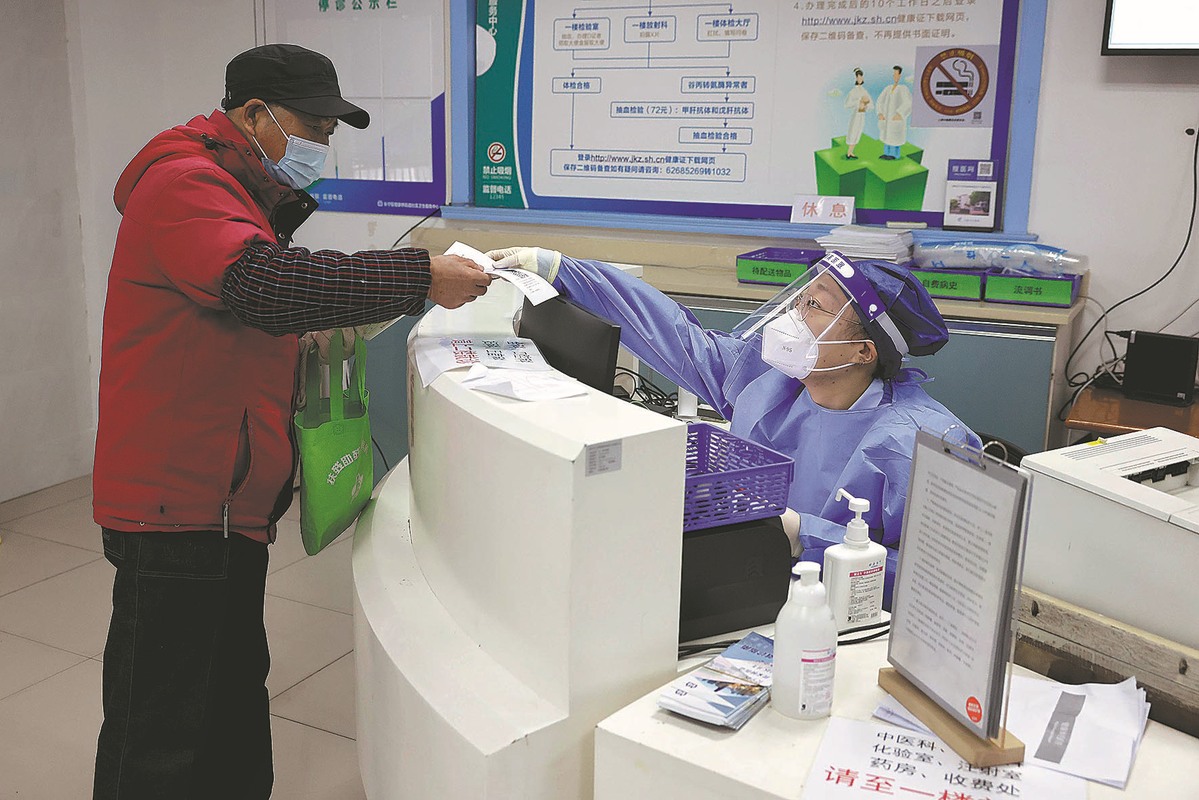Hospitals prepared for surge in cases

A medical worker registers a patient at a community fever clinic in Shanghai on Sunday. Community fever clinics are being used to relieve pressure on major hospitals. YIN LIQIN/CHINA NEWS SERVICE
Senior health official calls for increased coordination among medical facilities
Hospitals should make use of all medical resources available to cope with surging COVID-19 patients, according to a senior health official.
Jiao Yahui, head of the bureau of medical administration of the National Health Commission, said when fever clinics have a large number of patients, all beds, equipment and medical workers in hospitals need to be coordinated to assist, and when emergency intensive care units are too busy, the entire hospital also needs to coordinate.
The commission has asked emergency ICUs to transfer patients to other departments within 24 hours to make sure more severe patients receive treatment, Jiao said in an interview with China Central Television.
She said when measures are taken to flatten the peak of infection and hospitalization, existing medical resources are enough to cope with the epidemic.
As of Dec 25, major hospitals in the country had opened 16,000 fever clinics, and another 41,000 fever clinics had been opened by grassroots medical institutions, she said.
However, it is still not enough. Therefore, in Beijing, temporary fever clinics were also opened in gymnasiums and makeshift hospitals to provide drugs to patients with mild symptoms. As the number of severe patients rises, the pressure on ICUs becomes more acute, making it difficult to get an ICU bed, she said.
The commission issued guidelines in early December on expanding ICU resources and asked hospitals to prepare convertible ICU beds.
Efforts are required to make sure there is early intervention and treatment to prevent patients with mild symptoms from worsening into severe patients, she said, adding grassroots medical institutions have been asked to shift through high-risk groups and divide them into different levels based on their health conditions.
With Spring Festival approaching and the mass movement of people from cities to rural areas, Jiao said she was worried about the epidemic situation in the countryside.
The key is to make sure rural areas have sufficient stores of drugs for even after the Spring Festival travel rush and that all severe patients in rural areas can be transferred to bigger hospitals in time for treatment, she said.
Responding to complaints about difficulty in getting drugs, Jiao said it has been mainly caused by hoarding. In addition, it takes time for drug companies to increase production capacity and there is also a lack of workers at the companies as some have been infected, she said.
As there are more severe elderly patients who want to get treatment in top hospitals, the mismatch between demand and supply will also become more serious, Jiao said.
Tong Zhaohui, vice-president of Beijing Chaoyang Hospital Affiliated to Capital Medical University, said that compared with previous epidemics, the number of patients infected with the Omicron variant and needing hospitalization and ICU treatment is still low.
The number of serious and severe patients at two Beijing hospitals he has been working at account for 3 to 4 percent of the total, he said.
He acknowledged that there have been more deaths, but the number of critical patients and patients with pneumonia symptoms is still low.
Jiao said people might feel that the number of severe patients and deaths is high, and it is because China has a large population.
Difficulty getting medical treatment due to COVID-19 infection peaks has also happened in other countries in the past three years, and what makes China unique is that medical workers in the country have always fought the battle without any hesitation, she said.
"Some have been infected themselves and some have family members infected, and they still fight on the front line, just like soldiers going into battle."
The most difficult time is the peak in the number of severe patients that some cities are experiencing right now, but the infection curve will turn downward afterward, she added.
Photos
Related Stories
- All countries' COVID-19 response measures should be science-based: spokesperson
- Police authority orders crackdown on counterfeit COVID-19-related drugs
- Chinese hospitals go all out to treat severe COVID-19 patients
- Commentary: China's optimized COVID-19 strategy is a planned, science-based approach
- Factbox: China's anti-COVID-19 medical supplies production at full steam
Copyright © 2023 People's Daily Online. All Rights Reserved.









